Review by Jeff Wilson and Peter Bleakney, photos by Rob Smith
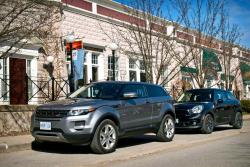 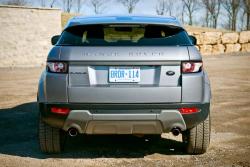 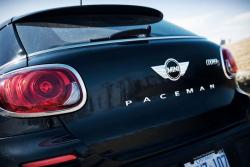 2013 Range Rover Evoque & 2013 Mini Paceman. Click image to enlarge |
At first glance, it appears that what we have here are the automotive equivalents of Paris Hilton and Kim Kardashian: all style and no substance. In reality though, that assertion is a little unfair, since the Range Rover Evoque Coupe and Mini Paceman do offer some usefulness and are surely easier to live with on a daily basis.
Instead, let’s consider these stylish crossovers CUAVs – Compact Urban Assault Vehicles – perfect for big city fashionistas sashaying around traffic-clogging cityscapes as they make their way to the next pedi appointment. Condensed dimensions with elevated seating positions ensure the diva drivers will have clear sightlines, and generous suspension travel ensures inner-city craters won’t upset the skinny chai lattes in the cup holders.
Where these two hot-hatches-in-hiking boots really excel is in whisking two active urbanites out of the big city to their trendy leisure activity of choice. So, tying pastel-hued sweaters around our shoulders, Peter Bleakney and I did our best impression of what it must be like to be hip, young city-dwellers free of obligations or cares and headed out for a drive around Niagara’s wine country. Our mission was not to collect cases of award-winning Rieslings, but evaluate these vehicular anomalies on their most valuable purchase influencing factors.
Impracticality Factor, Peter Bleakney
What has four doors, eight cylinders, gets lots of stares and has a back seat you don’t want to be in?
Cop car? Good guess, but not what we’re looking for. The correct answer: a 2013 Mini Cooper S Paceman ALL4 and a 2013 Land Rover Range Rover Evoque Coupe [Is there an award for longest name that I haven’t heard about? –Ed.].
Of course no one will be choosing these compact British hatchbacks for much other than their high style – there are four-door versions of each that provide a modicum more utility. This pair is all about the look. Form reigns over function here, but how far are these funsters from any practical considerations? Can they really function as useful daily drivers? Will backseat passengers immediately un-friend you on Facebook?
Being the larger of the two (although not by as much as you’d think), the Range Rover has the most commodious rear seat – and it will seat three in a pinch (and I do mean pinch), whereas the Mini Pacemen has only two bucket seats in the back. Looking at the Evoque’s rakish silhouette, you’d be forgiven for thinking headroom was in short supply. On the contrary; once positioned, knee room and headroom are surprisingly generous and the seats nicely contoured for two – it’s just those tapered windows make for a claustrophobic feel.
You can’t be in a hurry to get back there – it takes an eternity for the front seats to electrically slide forward. Not good if you have fidgety kids friends who’ve consumed one too many espresso. In contrast, tip the Mini’s front seats ahead and they instantly slide forward, allowing quick access. As might be expected, it’s considerably tighter once you squeeze into the Paceman. For me, at just under six feet, sitting “behind myself” was next to impossible. Acceptable headroom, though.
    2013 Range Rover Evoque & 2013 Mini Paceman. Click image to enlarge |
An interesting feature of the Mini Paceman (that could qualify as functional) is the cool rail-system separating the seats. Elements like cup holders and a sunglasses case slide on the rails in an industrial urban-chic way, but the whole thing feels so cheap and flimsy I was afraid to mess with it for fear of breaking something.
Space behind the rear seats in the Mini is fine for a load of groceries, some overnight bags, and even a small set of golf clubs. Flip up the floor panel and there is a good-sized hidden compartment. You have to remove the headrests and the groovy cup holders on the rails (if so equipped) to fold the back seats down, and then they aren’t flat.
The Evoque has a considerably more commodious hatch and the seats fold almost flat, although there is no compartment under the floor.
Rear visibility in the Mini Paceman is pretty dismal. In the Evoque it’s laughable. As Jeff noted, when someone in an SUV is riding your bumper, all you see through the rear slit is the part of their face between their upper lip and their eyebrows.
But we must not forget the Evoque’s other major attribute that is often overshadowed by its stunning looks. Being a Range Rover, it has honest-to-gawd off-road credibility thanks to full-time all-wheel-drive, selectable terrain response and approach and departure angles that put all other cute utes in the wannabe category.
In this contest, the win goes to the Evoque.
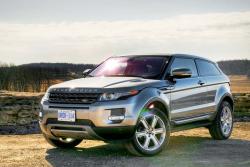 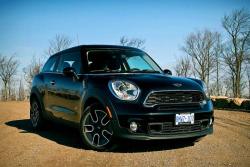 2013 Range Rover Evoque & 2013 Mini Paceman. Click image to enlarge |
Style, Jeff Wilson
One of these crossovers is a natural beauty; the other is fun and has a good personality. From any angle, the smallest Range Rover is as sexy as you will ever find a crossover vehicle.
Seldom does the world see a concept that transitions so untouched from auto show styling exercise to production as the Evoque has done. Sleek, squinty headlights sweep back into muscular arches stretched over 19-inch wheels (or optional 20s).
The steeply raked windshield meets a roof that slopes to an impossibly squat backlight. The side windows are so short that my three-year-old son perched in his car seat has a view of only the windowsill. Nothing else looks like the Evoque, and with the R A N G E R O V E R word mark tattooed to the snout, it’s got the brand cachet to match its over-the-top looks.
On its own, the Paceman appears to be a successful styling improvement over the pudgy and awkward-looking Countryman on which it’s based, but parked next to the Evoque, the Mini is merely a goofy-looking caricature with wide eyes and gaping maw. Peter described the Paceman as a “sad guppy”, an apt mental image I couldn’t shake for the rest of the drive. Mini fans that have outgrown their Cooper S hatchback will likely forgive the Paceman’s styling, but for the rest of us urban style mavens, we simply see a brand that’s being stretched too far.
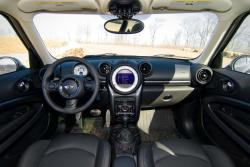 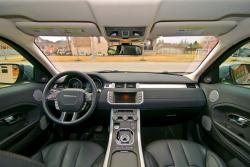
2013 Mini Paceman & 2013 Range Rover Evoque. Click image to enlarge |
Inside the Paceman, the fashion faux pas continue with love-it-or-hate it ergonomics comprised of toggle switches and a dinner-plate-sized speedometer that houses the nav screen in its inner ring. More distressing, though, are rock-hard plastics and generally cheap-feeling trim textures that wouldn’t pass muster in a Kia these days. Quirky cool might work on a twenty-four-grand Cooper, but the Paceman Cooper S All4 you see here is nearly 40 large.
Despite its rebellious outward appearance, the Evoque’s posh Range Rover lineage shines throughout its interior. Equipped with the Pure Plus Package, the aroma of rich leather abounds. The dash-top has a pebbled grain to the soft-touch plastics and the centre stack presents all the key controls at hand. The rise-to-greet-you shift rotary knob found exclusively on Jags and Land Rovers is a cool touch to impress friends.
That’s 2-0 for the Evoque.
Driving Dynamics, PB
I will admit to approaching the 2013 Mini Cooper S Paceman ALL4 with a great sloshing bucket of skepticism. I mean, really, how far can BMW go with this ever-expanding Mini thing? Great. So they created a two-door Countryman, haven’t we already been there, done that?
Ah, but closer inspection reveals Mini has more than just restyled a Countryman. All Pacemans (Pacemen?) come with a sports suspension, ride 10 mm closer to terra firma and have lower seat cushions too.
Initial driving impressions confirm the Mini DNA. The 181-hp 1.6L turbo four hauls with a snarly eager enthusiasm to the redline. The steering is weighty, direct, if a tad wooden.
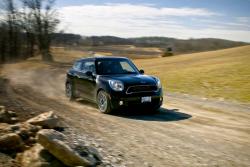 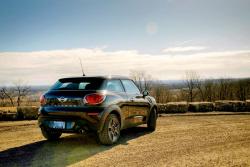 2013 Mini Paceman. Click image to enlarge |
But wait. Something is missing. Oh, it’s the usual crap Mini ride that does its best to shake you, and the car, to pieces. And where’s the torque steer? And the steering is more linear – not as darty as the standard Mini.
Hmmmm. Maybe they are on to something here. This Paceman version of the Mini seems to have hit a sweet spot. And while its trademark “go kart” personality may have been tempered, it still loves to get up on its toes and play hard. Over the few stretches of challenging roads on our test loop, the Paceman proved to be a hoot. It’s easy to get a flow, and sure, the snow tires compromised grip but not the fun.
This car was equipped with the optional six-speed auto ($1,300) with shift paddles – unfortunately the redundant push-me-pull-you variety that are completely at odds with the industry standard of left for downshift, right for upshift. Which the Range Rover has for its six-speed auto.
These ones require a complete reprogramming of your engrained instincts – push for upshifts and a pull for downshifts. Dumb. Why? That said, the tranny responds quickly and in sport mode (the shift lever tapped to the left), it will hold gears to redline, although it upshifts automatically once there.
Shift paddles aside, all in all a satisfying drivetrain. The all-wheel drive, as noted, mitigates torque steer, adds a bit more neutrality, and while we were scampering up a dirt incline for photos, it gave it a degree of grip and security no front-drive Mini can match.
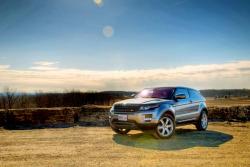 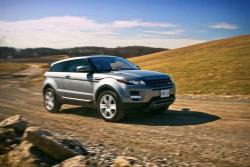 2013 Range Rover Evoque. Click image to enlarge |
And on to the runway model. The Evoque proved to be no slouch either on these twisty roads. The steering is lighter than the Mini’s, but linear and accurate, and its taut body control lent it no uncertain athleticism when pressing on. But unlike the Mini, which generally seemed happier the more you pushed it, at a certain point (and this was well beyond what you might call prudent) the Evoque got a bit ragged and lapsed into understeer – certainly the winter rubber didn’t help here.
While I didn’t spend as much time with the Rangie as Jeff, he noted that in day-to-day driving it was hard to get a smooth launch due to the surging turbo power delivery. Once underway though, the 240-hp and 251 lb-ft 2.0L turbo four (essentially Ford’s 2.0 EcoBoost) moves the RR smartly, and the (proper) paddles select the gears quickly.
One thing I didn’t like was the stiff-legged ride. It seems the Evoque never really settles down – even on the highway. While this might sound completely bizarre, in my view the Mini has a slightly more agreeable ride than the Range Rover. Wow.
As Jeff said, the Range Rover Evoque feels like a crossover trying to be a hot hatch, while it is the reverse for the Mini Paceman.
So for out-and-out driving fun, I give the nod to the mutant Mini.
Value, Jeff Wilson
Surely regular forum readers will decry “nobody will cross-shop a nearly $55,000 car with one costing nearly $20,000 less”, and if a shopper is stretching his or her budget to meet the Paceman’s cost of admission, then they’re right. However, there are a significant number of fairly affluent folks who live, work and play in the downtown, requiring a car as an occasional luxury and far from a necessity.
For those shoppers, shelling out mega bucks for a tiny sports car or an over-sized luxo-barge is pointless. But both of these cars offer easy-to-park size, all-weather capability and just enough space for Biff, Muffy and their labradoodle to get out of the city for the occasional weekend away. What’s more, they do so flying the badge of a British marque now marketed as a premium brand.
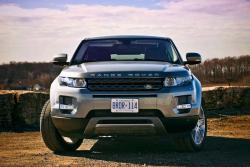 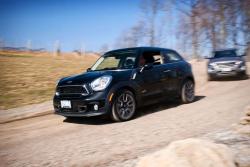 2013 Range Rover Evoque & 2013 Mini Paceman. Click image to enlarge |
So, which is the better value for the image-conscious urbanite? The Evoque Coupe starts at $48,095 in “Pure” trim. Our test car had the $4,500 Pure Plus Package that includes power-adjustable leather seating, power tailgate, parking sensors, 19-inch wheels and a gigantic, fixed-glass roof. What spending more than $53,000 does not get you is navigation, which is an additional $2,000.
The Paceman starts at $31,200 and when topped up with all the amenities found on the Range Rover (except fragrant cow hides) plus navigation, comes in at $37,580.
The smaller, lighter Mini will consume less fuel, too. Driving our test loop, (which featured divided highway and twisty back roads alike) the Paceman delivered a 9.3 L/100 km average versus the Evoque’s 11.1 L/100 km average. Both cars require premium fuel.
Score: 2 – 2.
|
Related Articles: Manufacturer’s Website: Photo Gallery: |
Conclusion
Either one of these freakish crossovers makes a unique statement about its owner. They announce to the world that the driver is too cool to buy the more practical four-door counterpart and that fashion really matters. The Mini is the more playful and economical choice, but the Range Rover Evoque has the undeniable sex appeal and gravitas. It all comes down to how much one wants to (or can) spend on relative vehicular frivolity, because each one succeeds as a fashion-first CUAV.
Competitors:
Spa membership
Diamond-encrusted bag from Tiffany’s
Condo in the city








